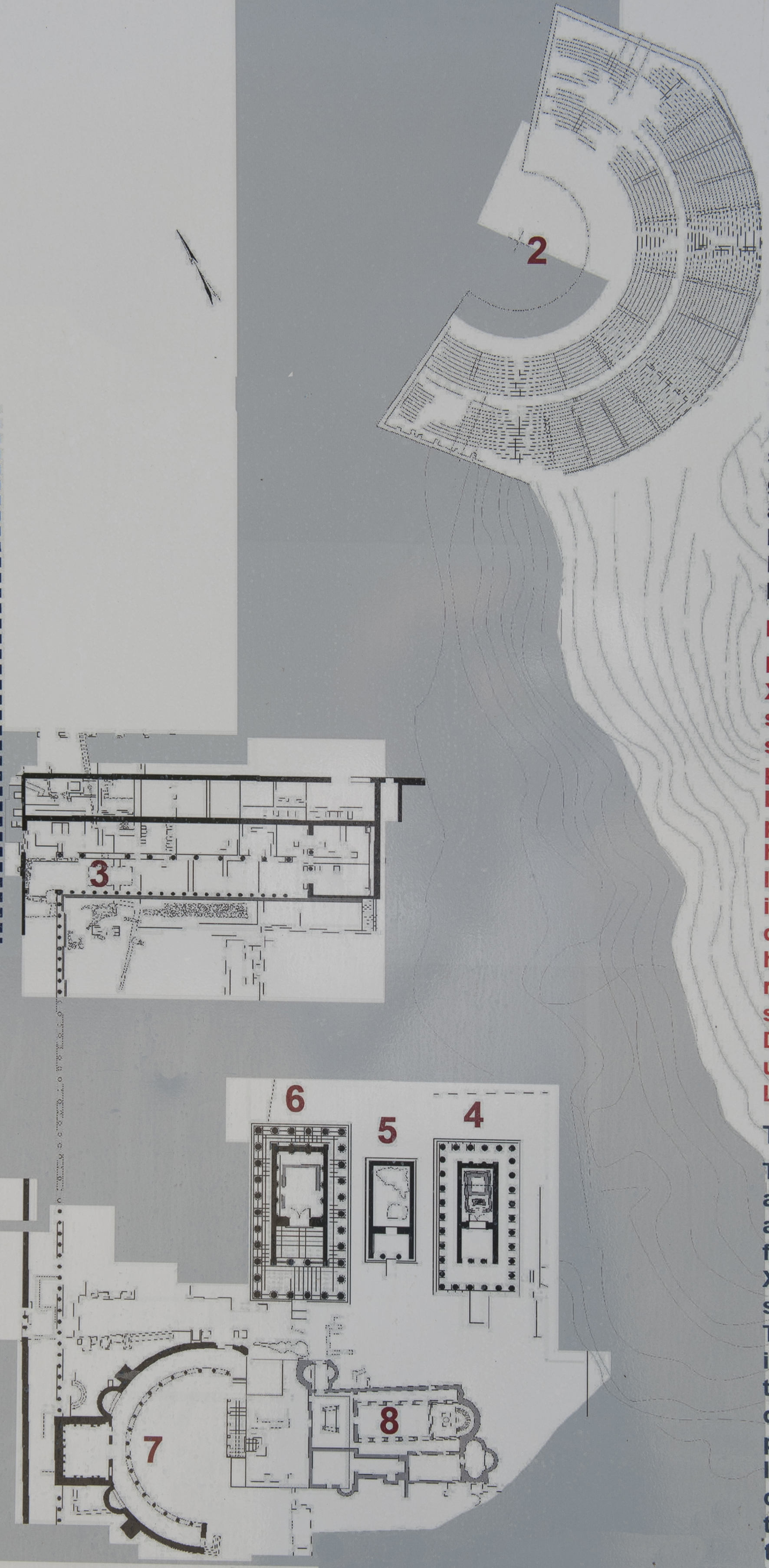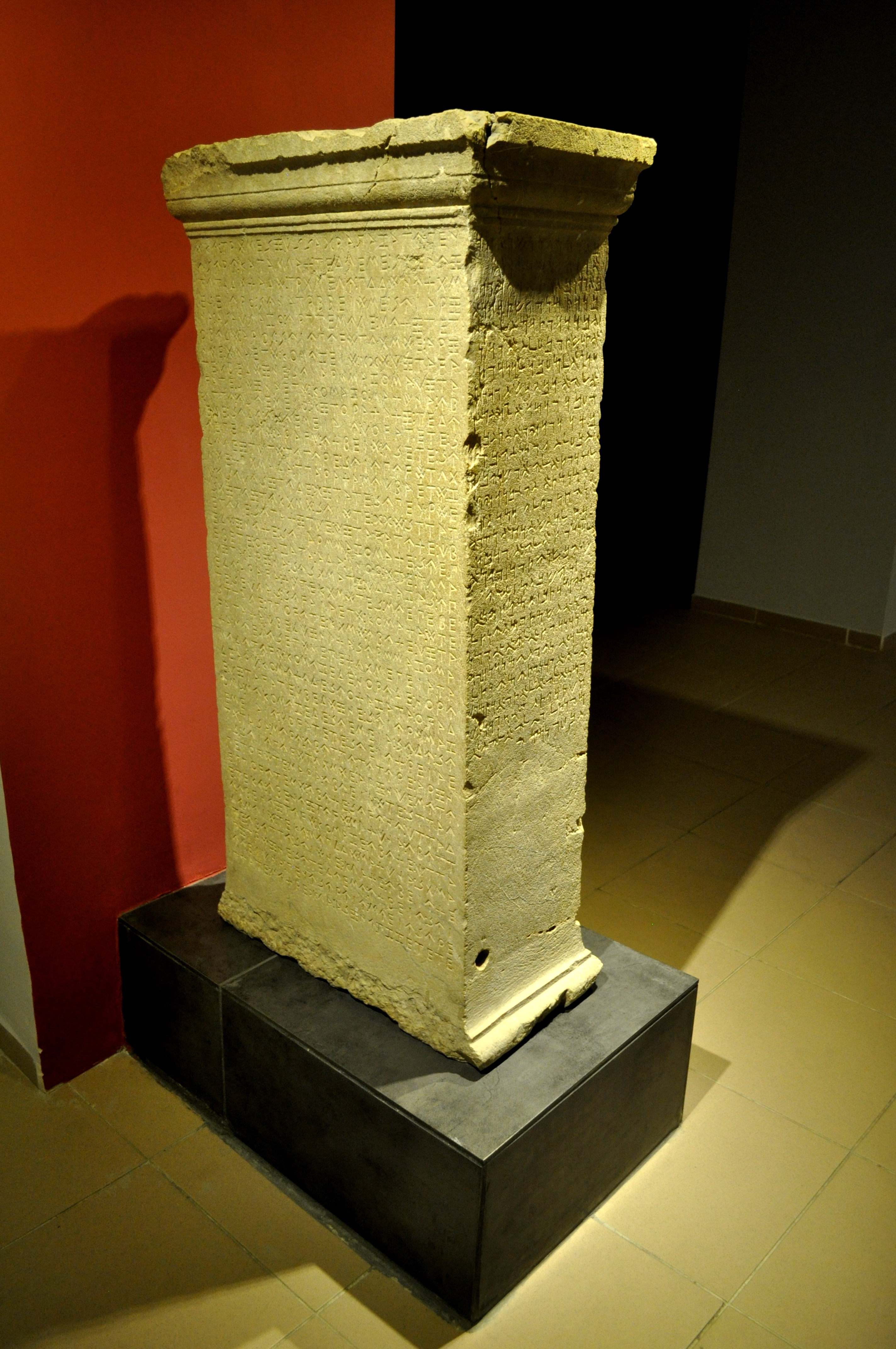|
Letoon Stele
The Letoon ( grc, Λητῷον), sometimes Latinized as Letoum, was a sanctuary of Leto located 4km south of the ancient city of Xanthos to which it was closely associated, and along the Xanthos River. It was one of the most important religious centres in the region though never a fully-occupied settlement. The site is located south of the village Kumluova in the Fethiye district of Muğla Province, Turkey. It was added as a UNESCO World Heritage Site along with Xanthos in 1988. History Archaeological finds at the site date to the late sixth century BC. This was before the Greek cultural hegemony in Lycia, which began in the early fourth century. In earlier times, the site was probably already sacred to the cult of an earlier mother goddess — she is ''Eni Mahanahi'' in Lycia — which was superseded by the worship of Leto, joined by her twin offspring. In Greek mythology, a claim for an early cult of Apollo in the valley of the Xanthus, unsupported by history or archaeo ... [...More Info...] [...Related Items...] OR: [Wikipedia] [Google] [Baidu] |
Muğla Province
Muğla Province ( tr, , ) is a province of Turkey, at the country's south-western corner, on the Aegean Sea. Its seat is Muğla, about inland, while some of Turkey's largest holiday resorts, such as Bodrum, Ölüdeniz, Marmaris and Fethiye, are on the coast in Muğla. Etymology The original name of Muğla is open to debate. Various sources refer to the city as Mogola, Mobella or Mobolia. Geography At , Muğla's coastline is the longest among the Provinces of Turkey and longer than many countries' coastlines, (even without taking any small islands into account). Important is the Datça Peninsula. As well as the sea, Muğla has two large lakes, Lake Bafa in the district of Milas and Lake Köyceğiz. The landscape consists of pot-shaped small plains surrounded by mountains, formed by depressions in the Neogene. These include the plain of the city of Muğla itself, Yeşilyurt, Ula, Gülağzı, Yerkesik, Akkaya, and Yenice). Until the recent building of highways, transport fr ... [...More Info...] [...Related Items...] OR: [Wikipedia] [Google] [Baidu] |
Hellenistic
In Classical antiquity, the Hellenistic period covers the time in Mediterranean history after Classical Greece, between the death of Alexander the Great in 323 BC and the emergence of the Roman Empire, as signified by the Battle of Actium in 31 BC and the conquest of Ptolemaic Egypt the following year. The Ancient Greek word ''Hellas'' (, ''Hellás'') was gradually recognized as the name for Greece, from which the word ''Hellenistic'' was derived. "Hellenistic" is distinguished from "Hellenic" in that the latter refers to Greece itself, while the former encompasses all ancient territories under Greek influence, in particular the East after the conquests of Alexander the Great. After the Macedonian invasion of the Achaemenid Empire in 330 BC and its disintegration shortly after, the Hellenistic kingdoms were established throughout south-west Asia ( Seleucid Empire, Kingdom of Pergamon), north-east Africa ( Ptolemaic Kingdom) and South Asia ( Greco-Bactrian Kingdom, Indo-Gree ... [...More Info...] [...Related Items...] OR: [Wikipedia] [Google] [Baidu] |
Université Laval
Université Laval is a public research university in Quebec City, Quebec, Canada. The university was founded by royal charter issued by Queen Victoria in 1852, with roots in the founding of the Séminaire de Québec in 1663 by François de Montmorency-Laval, making it the oldest centre of higher education in Canada and the first North American institution to offer higher education in French. The university, which was founded in Old Québec, moved to a new campus in the 1950s in the suburban borough of Sainte-Foy–Sillery–Cap-Rouge. It is ranked among the top 10 Canadian universities in terms of research funding and holds four Canada Excellence Research Chairs. Like most institutions in Québec, the name "Université Laval" is not translated into English. History The university's beginnings go back to 1663 with the founding of the Grand Séminaire de Québec and 1668 with the founding of the Petit Séminaire by François de Montmorency-Laval, a member of the House of Laval ... [...More Info...] [...Related Items...] OR: [Wikipedia] [Google] [Baidu] |
Université Du Québec à Montréal
The Université du Québec à Montréal (English: University of Quebec in Montreal), also known as UQAM, is a French-language public university based in Montreal, Quebec, Canada. It is the largest constituent element of the Université du Québec system. UQAM was founded on April 9, 1969, by the government of Quebec, through the merger of the École des beaux-arts de Montréal, a fine arts school; the Collège Sainte-Marie, a classical college; and a number of smaller schools. Although part of the UQ network, UQAM possesses a relative independence which allows it to print its own diplomas and choose its rector. In the fall of 2018, the university welcomed some 40,738 students, including 3,859 international students from 95 countries, in a total of 310 distinct programs of study, managed by six faculties (Arts, Education, Communication, Political Science and Law, Science and Social science) and one school (Management). It offers Bachelors, Masters, and Doctoral degrees. It is ... [...More Info...] [...Related Items...] OR: [Wikipedia] [Google] [Baidu] |
Christianised Sites
The Christianization of sites that had been pagan occurred as a result of conversions in early Christian times, as well as an important part of the strategy of '' Interpretatio Christiana'' ("Christian reinterpretation") during the Christianization of pagan peoples. The landscape itself was Christianized, as prominent features were rededicated to Christian saints, sometimes quite directly, as when the island of Oglasa in the Tyrrhenian Sea was christened Montecristo. Early Christianity In the first centuries of Christianity churches were either house churches in whatever houses were offered for use by their owners, or were shrines on the burial-sites of martyrs or saints, which following the usual classical practice were invariably on the (then) edges of cities - the necropolis was always outside the ''polis''. In Rome the early basilica churches of St. Peter's, Saint Paul Outside the Walls and San Lorenzo fuori le Mura, all follow this pattern. This distinction was graduall ... [...More Info...] [...Related Items...] OR: [Wikipedia] [Google] [Baidu] |
Patara (Lycia)
Patara ( Lycian: 𐊓𐊗𐊗𐊀𐊕𐊀, ''Pttara''; el, Πάταρα) was an ancient and flourishing maritime and commercial city, capital of Lycia, on the south-west coast of Turkey near the modern small town of Gelemiş, in Antalya Province. It is the birthplace of Saint Nicholas in 270 AD, who lived most of his life in the nearby town of Myra (Demre). Only a small part of the site has been excavated and renovated, but with impressive results. The protection and archaeology of the site have been subject to fierce battles between archaeologists and illegal developers over many years. Location The site is a plain surrounded by hills and included in ancient times a large natural harbour, since silted up. Northeast of the harbour is Tepecik Hill upon which there is a Bronze Age site and which was the acropolis on which the city was founded. The city later spread to the south and west of the hill. It was one of the four largest settlements in the Xanthos Valley and th ... [...More Info...] [...Related Items...] OR: [Wikipedia] [Google] [Baidu] |
Sacred Grove
Sacred groves or sacred woods are groves of trees and have special religious importance within a particular culture. Sacred groves feature in various cultures throughout the world. They were important features of the mythological landscape and cult practice of Celtic, Estonian, Baltic, Germanic, ancient Greek, Near Eastern, Roman, and Slavic polytheism; they also occur in locations such as India, Japan ( sacred shrine forests), West Africa and Ethiopia ( church forests). Examples of sacred groves include the Greco-Roman ''temenos'', various Germanic words for sacred groves, and the Celtic ''nemeton'', which was largely but not exclusively associated with Druidic practice. During the Northern Crusades of the Middle Ages, conquering Christians commonly built churches on the sites of sacred groves. The Lakota and various other North American tribes regard particular forests or other natural landmarks as sacred places. Singular trees which a community deems to hold religious s ... [...More Info...] [...Related Items...] OR: [Wikipedia] [Google] [Baidu] |
Mithridates VI Of Pontus
Mithridates or Mithradates VI Eupator ( grc-gre, Μιθραδάτης; 135–63 BC) was ruler of the Kingdom of Pontus in northern Anatolia from 120 to 63 BC, and one of the Roman Republic's most formidable and determined opponents. He was an effective, ambitious and ruthless ruler who sought to dominate Asia Minor and the Black Sea region, waging several hard-fought but ultimately unsuccessful wars (the Mithridatic Wars) to break Roman dominion over Asia and the Hellenic world. He has been called the greatest ruler of the Kingdom of Pontus. He cultivated an immunity to poisons by regularly ingesting sub-lethal doses; this practice, now called mithridatism, is named after him. After his death he became known as Mithridates the Great. Etymology ''Mithridates'' is the Greek attestation of the Persian name ''Mihrdāt'', meaning "given by Mithra", the name of the ancient Iranian sun god. The name itself is derived from Old Iranian ''Miθra-dāta-''. Ancestry, family and early lif ... [...More Info...] [...Related Items...] OR: [Wikipedia] [Google] [Baidu] |
Appian
Appian of Alexandria (; grc-gre, Ἀππιανὸς Ἀλεξανδρεύς ''Appianòs Alexandreús''; la, Appianus Alexandrinus; ) was a Greek historian with Roman citizenship who flourished during the reigns of Emperors of Rome Trajan, Hadrian, and Antoninus Pius. He was born c. 95 in Alexandria. After holding the senior offices in the province of Aegyptus (Egypt), he went to Rome c. 120, where he practised as an advocate, pleading cases before the emperors (probably as ''advocatus fisci'', an important official of the imperial treasury). It was in 147 at the earliest that he was appointed to the office of procurator, probably in Egypt, on the recommendation of his friend Marcus Cornelius Fronto, an influential rhetorician and advocate. Because the position of procurator was open only to members of the equestrian order (the "knightly" class), his possession of this office tells us about Appian's family background. His principal surviving work (Ρωμαϊκά ''Romaiká'' ... [...More Info...] [...Related Items...] OR: [Wikipedia] [Google] [Baidu] |
Aramaic
The Aramaic languages, short Aramaic ( syc, ܐܪܡܝܐ, Arāmāyā; oar, 𐤀𐤓𐤌𐤉𐤀; arc, 𐡀𐡓𐡌𐡉𐡀; tmr, אֲרָמִית), are a language family containing many varieties (languages and dialects) that originated in the ancient region of Syria. For over three thousand years, It is a sub-group of the Semitic languages. Aramaic varieties served as a language of public life and administration of ancient kingdoms and empires and also as a language of divine worship and religious study. Several modern varieties, namely the Neo-Aramaic languages, are still spoken in the present-day. The Aramaic languages belong to the Northwest group of the Semitic language family, which also includes the Canaanite languages such as Hebrew, Edomite, Moabite, and Phoenician, as well as Amorite and Ugaritic. Aramaic languages are written in the Aramaic alphabet, a descendant of the Phoenician alphabet, and the most prominent alphabet variant is the Syriac alphabet. The ... [...More Info...] [...Related Items...] OR: [Wikipedia] [Google] [Baidu] |
Letoon Trilingual
The Letoon trilingual, or Xanthos trilingual, is an inscription in three languages: standard Lycian or Lycian A, Greek, and Aramaic covering the faces of a four-sided stone stele called the Letoon Trilingual Stele, discovered in 1973 during the archeological exploration of the Letoon temple complex (devoted to the goddess Leto), near Xanthos, ancient Lycia, in present-day Turkey. It was created when Lycia was under the sway of the Persian Achaemenid Empire. The inscription is a public record of a decree authorizing the establishment of a cult, with references to the deities, and provisions for officers in the new cult. The Lycian requires 41 lines; the Greek, 35 and the Aramaic, 27. They are not word-for-word translations, but each contains some information not present in the others. The Aramaic is somewhat condensed. First page displayable no charge. Although the use of the term "Letoon" with regard to the inscription and the stele is unequivocal, there is no standard name for ... [...More Info...] [...Related Items...] OR: [Wikipedia] [Google] [Baidu] |
Archeology
Archaeology or archeology is the scientific study of human activity through the recovery and analysis of material culture. The archaeological record consists of artifacts, architecture, biofacts or ecofacts, sites, and cultural landscapes. Archaeology can be considered both a social science and a branch of the humanities. It is usually considered an independent academic discipline, but may also be classified as part of anthropology (in North America – the four-field approach), history or geography. Archaeologists study human prehistory and history, from the development of the first stone tools at Lomekwi in East Africa 3.3 million years ago up until recent decades. Archaeology is distinct from palaeontology, which is the study of fossil remains. Archaeology is particularly important for learning about prehistoric societies, for which, by definition, there are no written records. Prehistory includes over 99% of the human past, from the Paleolithic until the adven ... [...More Info...] [...Related Items...] OR: [Wikipedia] [Google] [Baidu] |

.jpg)



.jpg)




.jpg)